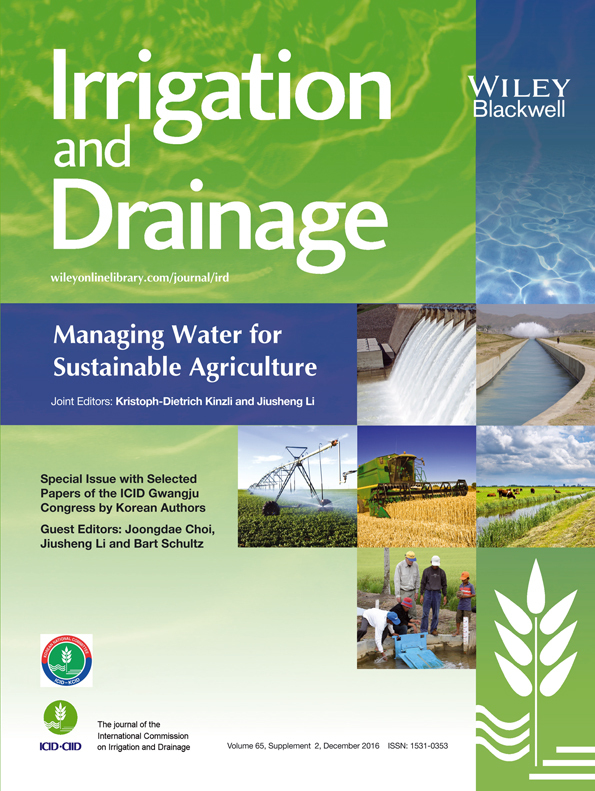Effect of Surface Cover on NPS Pollution from Sloping Fields under Intensive Farming in Korea†
Effet de la couverture de surface sur la pollution diffuse agricole sur des parcelles en pente et sous agriculture intensive, Corée
Abstract
enSloping fields under intensive farming have been a major source of agricultural nonpoint source (NPS) pollution in Korea. Comprehensive studies to quantify edge-of-field water quality and measure surface mulch effects on NPS pollution discharge have been conducted over the past several years. Edge-of-field water quality was seriously degraded by NPS pollutants. The range of average event mean concentrations (EMCs) was suspended solids (SS) 547 ~ 2600 mg l−1, biochemical oxygen demand (BOD) 8.7 ~ 50.7 mg l−1, total nitrogen (TN) 3.5 ~ 21.8 mg l−1, and total phosphorus (TP) 2.4 ~ 13.1 mg l−1. Experiments treated by a rice straw mat mulch (S), S with gypsum (SG), and SG with PAM (SPG) showed good results as best management practices (BMPs) in controlling NPS pollution from sloping fields. The range of reductions by the treatments was runoff 28.3 ~ 96.7%, SS 71.5 ~ 99.5%, BOD 37.5 ~ 91.9%, TN 32.4 ~ 91.0%, and TP 43.0 ~ 95.7%. The SPG showed the best reduction effect for both runoff and NPS pollution. The S also showed encouraging results as a prospective BMP. Crop yields under the treatments also increased by up to 740% (lettuce) and 6.1 ~ 39.2% (cabbage and radish). The mulch treatments were proven to be effective for the increase of farm productivity and to improve runoff quality as well. Copyright © 2016 John Wiley & Sons, Ltd.
Résumé
frLes champs en pente sous agriculture intensive ont été une source majeure pollution diffuse agricole en Corée. Des études générales visant à quantifier la qualité de l'eau en bout de parcelle et de mesurer les effets de paillis de surface sur la pollution diffuse été menées au cours des dernières années. La qualité de l'eau en bout de parcelle été sérieusement dégradée par la pollution diffuse. Les paillis ont consisté en un mulch de paille de riz avec (SG) ou sans (S) traitement complémentaire au gypse, et un traitement combinant les deux précédents avec du polyacrilamide (SPG). La gamme des concentrations pour des évènements moyens (EMCS) ont été, pour les matières solides en suspension (SS) de 5474 à 2.2600 mg l−1, la demande en oxygène bio-chimique (DBO) de 8.7 à 50.7 mg l−1, l'azote total (TN) de 3.5 à 21.8 mg l−1, et le phosphore total (TP) 2.4 à 13.1 mg l−1. Les traitements avec un paillis de natte de paille de riz (S), avec du gypse (SG), et SG avec PAM (SPG) ont montré de bons résultats pour contrôler la pollution diffuse. La gamme de réductions par les traitements ont été ruissellement 28.3 à 96.7%, SS 71.5 à 99.5%, DBO 37.5 à 91.9%, TN 32.4 à 91.0%, et TP 43.0 à 95.7%. Le SPG a montré le meilleur effet de la réduction à la fois pour les eaux de ruissellement et la pollution diffuse. Le S a également montré des résultats encourageants et pourraient constituer une bonne pratique de gestion. Les rendements des cultures dans le cadre des traitements ont aussi augmenté jusqu'à 740% (laitue) et de 6.1 à 39,2% (chou et le radis). Les traitements de paillis ont prouvé leur efficacité pour l'augmentation de la productivité agricole et l'amélioration de la qualité des eaux de ruissellement. Copyright © 2016 John Wiley & Sons, Ltd.




